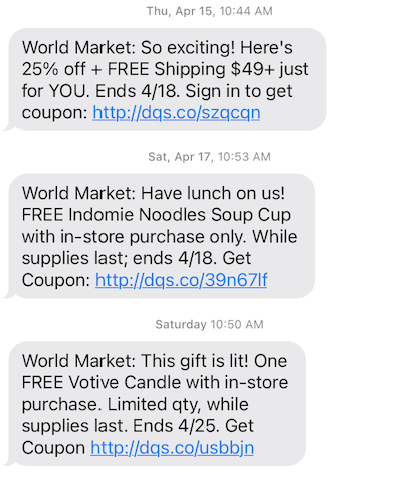One of today’s biggest challenges is finding the right way to get in front of your audience. With inboxes full and consumers scrolling quickly past ads on social media, it’s difficult to get noticed. This is where SMS marketing comes in.
Personalized text messages have emerged as an essential way for consumers to connect with brands. It’s an impactful addition to more common channels like email and push notifications, and, more importantly, it allows consumers to engage in two-way conversations with brands. The same two-way conversations that build rapport, kick-start relationships and increase loyalty.
SMS fits into the much larger scope of mobile marketing, but there is so much to be said about it that we wanted to talk to someone who’s in the trenches (metaphorically speaking) of SMS marketing.
In our latest installment of “Ask an Iterator,” we ask Jeremy Moffett, Manager of Enterprise Customer Success at Iterable, the most common SMS marketing questions he receives.
Ask an Iterator: Jeremy Moffett


Jeremy Moffett, Manager, Enterprise Customer Success.
Jeremy Moffett manages a team of Enterprise Customer Success Managers across the SF Bay Area and Denver area. Prior to Iterable, Jeremy worked on the Customer Success team at Sprinklr and, in addition, pursued his passion for wedding photography! When Jeremy’s not diving into complex and exciting customer scenarios with his team, he enjoys hiking around California’s diverse landscape, and spending evenings sipping a nice glass of mezcal or scotch.
Jeremy is here to answer the SMS marketing questions he receives most often when working with brands considering launching an SMS program. Let’s dive right in!
Why should marketers consider SMS?
Consumers have made it clear that they’re hungry for the opportunity to sign up for texts from the brands they’re interested in. In a recent survey, 91% of consumers noted their interest in signing up for texts from brands. Brands should be listening—they have a massive chance to capture consumers’ attention (and e-commerce revenue)!
Not only do almost 4 billion people own a smartphone, but they also touch them a surprising 2,617 times per day. And that’s just the average user.
The methods of engagement through SMS marketing are almost limitless. For example, you could fire out exclusive deals, schedule alerts, send personalized offers, run a survey or even create a contest.
As engaged as that smartphone cohort is, you also open yourself up to a broader audience who use cellphones regularly but don’t use smartphones.
How do I get my team to opt-in to SMS?
I remember, quite vividly, getting my first cell phone in high school. It was an iPhone—revolutionary for the time—and this was before those messages had a blue background. This was a time before texting was unlimited, a lesson I learned quickly! Fast forward to today, and, looking back, I am astounded at how much money it cost for me to stay connected.
So why am I telling this story? To explain that times have changed and technology has evolved. What was once expensive (SMS) is now economical to the average consumer, but can still be a challenging channel to adapt as a brand.
In fact, a well-timed SMS marketing campaign can be launched at a fraction of the cost of many traditional marketing methods. SMS campaigns are affordable for most budgets, and, at just a few pennies per message, marketers can be highly targeted with their campaigns without racking up the high costs.
Add to this that SMS messages have a 209% higher response rate than phone, email or Facebook. And nearly 30% of consumers will respond to your SMS message, with nearly 50% of these respondents making a purchase. Today it’s estimated that over 90% of SMS messages are seen and viewed within 5 minutes of receiving them.
High ROI and low cost? Argument enough to opt-in on SMS.
When is a good time to use SMS over email?
If we’re talking time-sensitive messaging, SMS is the best, most accessible channel, as customers typically view the message immediately upon receiving it. In addition to the real-time nature of SMS, it can be a great way to drive engagement on other channels and reinforce your other messages.
For example, you can use SMS to remind customers to read an email sent by a brand hours or even days before. This simple follow up can help increase email open rates by 20-30%. Alternatively, use SMS to communicate messages which may otherwise be forgotten—maybe encouraging habit building like the origin of the daily vitamins you’re now taking.
Does SMS Marketing only work with Millennials and Gen Z?
SMS is a useful marketing tool for any age group, but it’s, yes, especially helpful when marketing to Millennials and Gen Z. More than 5 years ago, close to 80% of consumers within that age range had their cell phones with them 22 hours a day. Phones aren’t simple communication tools for these generations. They’re an extension and representation of self.
With that said, Gen X and Baby Boomers can’t be discounted here. As of 2019, 90% of Gen X owns a smartphone and 68% of Baby Boomers, up from 25% in 2011. Mobile usage rates are increasing across the board and a text message is often the quickest way to reach someone. There’s a greater-than-good chance your SMS marketing will show results for all generations.
What resources are needed to implement an SMS marketing strategy?
SMS is a one-size-fits all channel for the marketers and consumers. SMS marketing is quick and only made up of text that’s likely only one or two sentences in length. Therefore, there is no requirement for a designer or copywriter, like with many marketing campaigns. The shorter and snappier the copy, the better. This is perfect for marketers who are short on time, or resources!
Planning and sending SMS messages is simple and straightforward, requiring less upfront strategy and planning than many other marketing methods. Additionally, as the copy is so short, the entire message can be quickly read and understood at the recipient’s convenience. This means the recipient can engage quickly, without feeling intruded upon.
How can my team get creative with SMS?
To make your marketing most effective, you really need to see where you can organically fit in to your customers’ everyday lives. The barrier to entry into a conversation with your brand has to be as low as you can make it, and at the same time, your brand’s messaging has to add value to customers. SMS, as a marketing channel, checks both of these boxes.
When I talk about SMS, I’m talking about two-way communications. I’m thinking about staying connected with friends and family. 23 billion text messages are sent each day worldwide, and many of these texts are components of ongoing conversations.
There’s nothing new about using conversations to move a customer through a marketing funnel or buying channel. It’s the original sales tool. But what has changed is the channel for these conversations—from in-person meetings, to phone calls, to SMS.
With SMS, you can automate the form-filling experience, ask easily answerable questions, request feedback and create lighthearted discount notices (here’s looking at you, Cost Plus World Market). SMS is the channel to start conversations, make connections and facilitate engagement with your brand.


Cost Plus World Market plays around with language and creativity while offering discounts via SMS marketing.
Get creative with SMS by infusing humanity in your marketing.
Any other SMS tips?
Transparency and cohesion is key! I’m a big fan of when a brand utilizes each channel to its strength. SMS is fantastic at getting attention and reminding consumers of something specific. Email is fantastic at displaying more information and linking to a specific web page. When combined, a brand can build good habits via SMS, like reminding you to take a daily walk, eat healthier or improve that skin care routine with tips that update over time.
Personalized skincare brand, Curology, does this really well; they identify which members aren’t engaging via SMS, and reach these individuals with targeted email follow-ups, tracking email and site metrics to ensure that they’re achieving relevance across all marketing channels.
For me, setting clear expectations up front and delivering something special, exclusive or otherwise detailed helps build your SMS cohort. This cohort won’t always be as large as many of your other cohorts, but they will tend to be the most loyal—actively participating and seeking out more opportunities to engage with your brand. Reward them accordingly with information or updates into your brand that can’t be found elsewhere.
Anything we didn’t ask that you’d like to share?
SMS, when done correctly, can be an incredibly effective marketing channel. But, because it takes work and consistency, most SMS campaigns miss the mark. More often than not, brands embrace the “basic” package of SMS utility, relying on one-time verification and shipping updates. These are great ways to get started with the channel, but certainly not the end goal.
My opinion? If you’re not having a two-way conversation, you’re not taking full advantage of the channel. If you’re looking to get started with SMS, look to brands like Zipcar, Chase, Bank of America, Amazon treasure truck, Venmo, Enterprise, Fedex, Robinhood and Apple.
Of course, I’d be remiss if I didn’t end with a word of caution. Today’s customers demand transparency and morality from the brand. They shop with brands that show they care about ethics, the world and their customers. Before you settle with SMS make sure you have healthy (and ethical) practices in place.
“BRB, Opt-ing in to SMS Marketing”
You heard it from Jeremy—SMS marketing is the way to go to connect with customers. Today’s customers want to shop with brands that share their values, and that they have an emotional connection with. There’s no better way to build that connection than through a conversation. And there’s few channels better suited for a conversation than SMS.
While we didn’t have time to dive into the details of campaign-building with SMS, we’ve got you covered. We have a major breakdown of some SMS marketing tips in our guide, The Inside Look at Mobile Marketing.





























